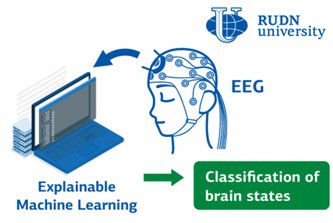RUDN scientist named the best neural network for diagnosing brain pathologies

One of the key stages in the diagnosis of brain pathologies is neuroimaging. This is the visualization of brain activity and brain tissue using CT, X-ray, electroencephalogram (EEG) and other methods. The interpretation of the results of such analyzes is carried out by specially trained professionals. But even an experienced eye can not always draw the right conclusion. Artificial intelligence can help in interpretation. Since we are talking about a doctor-computer tandem, and not about replacing a person with artificial intelligence, such models are needed that not only give the result, but can “explain” why it turned out that way. This property is called interpretability. A RUDN researcher with colleagues from the Baltic Federal University selected the best models that are suitable for this purpose.
“Artificial intelligence in the analysis of biological and medical data is an important and actively researched area. This also applies to the analysis of medical images. One of the central points here is interpretability. This is important for decision-making systems, when a medical worker must understand and interpret the result of the work of artificial intelligence. Therefore, it is important to develop different neuroimaging approaches that are interpretable. Our goal was to find a good mathematical model for classifying brain states with an emphasis on the interpretability of the results,” Alexander Hramov, Doctor of Science in Physics and Mathematics, Leading Researcher at the RUDN University Department of Transport, Chief Researcher at the Baltic Center for Neurotechnologies and Artificial Intelligence, Immanuel Kant Baltic Federal University.
To find the best models, the researchers used EEG data taken from patients as they looked at different images. The first is the famous Mona Lisa painting, and the second is the optical illusion of the Necker Cube, which depicts a simple frame of a cube. The fact is that the figure does not indicate which faces are in front and which are behind. A person usually does not notice the contradiction and interprets the picture unambiguously, but for a computer this task is not so simple. Therefore, the Necker cube is used to test computer models of the human perceptual system. Five people took part in the experiment. Based on the results of the EEG, the neural network had to determine the brightness of the image that a person sees. In addition, using a special algorithm, the neural network identifies specific parameters that influenced the final decision of the model.
The engineers compared several models of artificial neural networks. The model with the so-called adaptive gradient algorithm (adagrad) turned out to be the best. This is an optimization method that tunes the neural network based on the frequency with which this or that feature occurs. A neural network with an adaptive gradient made it possible to achieve a model accuracy of 92.9%.
“Adagrad turned out to be the best optimization method. Our results will help to select suitable explainable machine learning methods for the correct training of brain-computer interfaces,” Alexander Hramov, Doctor of Science in Physics and Mathematics, Leading Researcher at the Department of Transport of the RUDN University, Chief Researcher at the Baltic Center for Neurotechnologies and Artificial Intelligence of Immanuel Kant Baltic Federal University.
The results are published in Mathematics.
RUDN summarized the results of the scientific competition "Project Start: work of the science club ". Students of the Faculty of Physics, Mathematics and Natural Sciences have created a project for a managed queuing system using a neural network to redistribute resources between 5G segments. How to increase flexibility, make the network fast and inexpensive and reach more users — tell Gebrial Ibram Esam Zekri ("Fundamental Computer Science and Information Technology", Master's degree, II course) and Ksenia Leontieva ("Applied Mathematics and Computer Science", Master's degree, I course).
The National Demographic Report, 2023 Demographic Well-Being of Russian Regions (hereinafter - the National Demographic Report) was prepared by the scientific team of the Institute of Demographic Studies of the Federal Research Center of the Russian Academy of Sciences, the Vologda Scientific Center of the Russian Academy of Sciences, Peoples' Friendship University of Russia, the Center for Family and Demography of the Academy of Sciences of the Republic of Tatarstan, as well as with the participation of leading scientists from the Republic of Bashkortostan, Stavropol Krai, Volgograd, Ivanovo, Kaliningrad, Nizhny Novgorod, Sverdlovsk Oblasts and Khanty-Mansi Autonomous Okrug–Yugra.
RUDN summarized the results of the scientific competition "Project Start: work of the science club ". Students of the Faculty of Physics, Mathematics and Natural Sciences have created a project for a managed queuing system using a neural network to redistribute resources between 5G segments. How to increase flexibility, make the network fast and inexpensive and reach more users — tell Gebrial Ibram Esam Zekri ("Fundamental Computer Science and Information Technology", Master's degree, II course) and Ksenia Leontieva ("Applied Mathematics and Computer Science", Master's degree, I course).
What is your first association with the word “laboratory”? Flasks and beakers? Microscopes and centrifuges? Yes, many of us would answer the same way.
The National Demographic Report, 2023 Demographic Well-Being of Russian Regions (hereinafter - the National Demographic Report) was prepared by the scientific team of the Institute of Demographic Studies of the Federal Research Center of the Russian Academy of Sciences, the Vologda Scientific Center of the Russian Academy of Sciences, Peoples' Friendship University of Russia, the Center for Family and Demography of the Academy of Sciences of the Republic of Tatarstan, as well as with the participation of leading scientists from the Republic of Bashkortostan, Stavropol Krai, Volgograd, Ivanovo, Kaliningrad, Nizhny Novgorod, Sverdlovsk Oblasts and Khanty-Mansi Autonomous Okrug–Yugra.